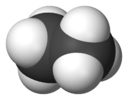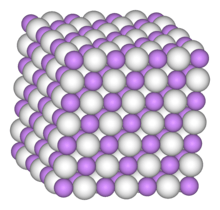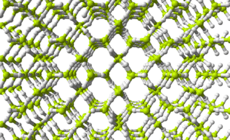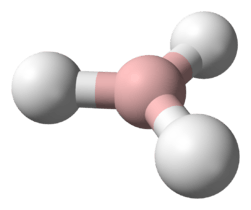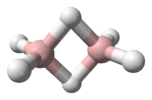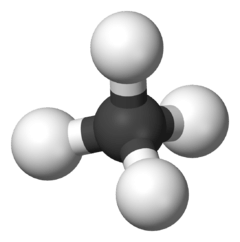Ethane
Ethane (/ˈɛθeɪn/ or /ˈiːθeɪn/) is an organic chemical compound with chemical formula C
2H
6. At standard temperature and pressure, ethane is a colorless, odorless gas. Like many hydrocarbons, ethane is isolated on an industrial scale from natural gas and as a petrochemical by-product of petroleum refining. Its chief use is as feedstock for ethylene production.
| |||
| |||
| Names | |||
|---|---|---|---|
| Preferred IUPAC name
Ethane[1] | |||
| Systematic IUPAC name
Dicarbane (never recommended[1]) | |||
| Identifiers | |||
3D model (JSmol) |
|||
| 1730716 | |||
| ChEBI | |||
| ChEMBL | |||
| ChemSpider | |||
| ECHA InfoCard | 100.000.741 | ||
| EC Number |
| ||
| 212 | |||
| MeSH | Ethane | ||
PubChem CID |
|||
| RTECS number |
| ||
| UNII | |||
| UN number | 1035 | ||
CompTox Dashboard (EPA) |
|||
| |||
| |||
| Properties | |||
| C2H6 | |||
| Molar mass | 30.070 g·mol−1 | ||
| Appearance | Colorless gas | ||
| Odor | Odorless | ||
| Density |
544.0 kg/m3 (liquid at -88,5 °C) | ||
| Melting point | −182.8 °C; −296.9 °F; 90.4 K | ||
| Boiling point | −88.5 °C; −127.4 °F; 184.6 K | ||
| 56.8 mg L−1[3] | |||
| Vapor pressure | 3.8453 MPa (at 21.1 °C) | ||
Henry's law constant (kH) |
19 nmol Pa−1 kg−1 | ||
| Acidity (pKa) | 50 | ||
| Basicity (pKb) | -36 | ||
| Conjugate acid | Ethanium | ||
| -37.37·10−6 cm3/mol | |||
| Thermochemistry | |||
Heat capacity (C) |
52.49 J K−1 mol−1 | ||
Std enthalpy of formation (ΔfH⦵298) |
−84 kJ mol−1 | ||
Std enthalpy of combustion (ΔcH⦵298) |
−1561.0–−1560.4 kJ mol−1 | ||
| Hazards | |||
| Safety data sheet | See: data page inchem.org | ||
| GHS pictograms |  | ||
| GHS Signal word | Danger | ||
GHS hazard statements |
H220, H280 | ||
| P210, P410+403 | |||
| NFPA 704 (fire diamond) | |||
| Flash point | −135 °C (−211 °F; 138 K) | ||
| 472 °C (882 °F; 745 K) | |||
| Explosive limits | 2.9–13% | ||
| Related compounds | |||
Related alkanes |
|||
Related compounds |
|||
| Supplementary data page | |||
| Refractive index (n), Dielectric constant (εr), etc. | |||
Thermodynamic data |
Phase behaviour solid–liquid–gas | ||
| UV, IR, NMR, MS | |||
Except where otherwise noted, data are given for materials in their standard state (at 25 °C [77 °F], 100 kPa). | |||
| Infobox references | |||
Related compounds may be formed by replacing a hydrogen atom with another functional group; the ethane moiety is called an ethyl group. For example, an ethyl group linked to a hydroxyl group yields ethanol, the alcohol in beverages.
History
Ethane was first synthesised in 1834 by Michael Faraday, applying electrolysis of a potassium acetate solution. He mistook the hydrocarbon product of this reaction for methane and did not investigate it further.[4] During the period 1847–1849, in an effort to vindicate the radical theory of organic chemistry, Hermann Kolbe and Edward Frankland produced ethane by the reductions of propionitrile (ethyl cyanide)[5] and ethyl iodide[6] with potassium metal, and, as did Faraday, by the electrolysis of aqueous acetates. They mistook the product of the reactions for methyl radical rather than the dimer of methyl, ethane. This error was corrected in 1864 by Carl Schorlemmer, who showed that the product of all these reactions was in fact ethane.[7] Ethane was discovered dissolved in Pennsylvanian light crude oil by Edmund Ronalds in 1864.[8][9]
The name ethane is derived from the IUPAC nomenclature of organic chemistry. "Eth-" is derived from the German for potable alcohol (ethanol),[10] and "-ane" refers to the presence of a single bond between the carbon atoms.
Properties
At standard temperature and pressure, ethane is a colorless, odorless gas. It has a boiling point of −88.5 °C (−127.3 °F) and melting point of −182.8 °C (−297.0 °F). Solid ethane exists in several modifications.[11] On cooling under normal pressure, the first modification to appear is a plastic crystal, crystallizing in the cubic system. In this form, the positions of the hydrogen atoms are not fixed; the molecules may rotate freely around the long axis. Cooling this ethane below ca. 89.9 K (−183.2 °C; −297.8 °F) changes it to monoclinic metastable ethane II (space group P 21/n).[12] Ethane is only very sparingly soluble in water.
The bond parameters of ethane have been measured to high precision by microwave spectroscopy and electron diffraction: rC–C = 1.528(3) Å, rC–H = 1.088(5) Å, and ∠CCH = 111.6(5)° by microwave and rC–C = 1.524(3) Å, rC–H = 1.089(5) Å, and ∠CCH = 111.9(5)° by electron diffraction (the numbers in parentheses represents the uncertainties in the final digits).[13]
Chemistry
Ethane can be viewed as two methyl groups joined, that is, a dimer of methyl groups. In the laboratory, ethane may be conveniently synthesised by Kolbe electrolysis. In this technique, an aqueous solution of an acetate salt is electrolysed. At the anode, acetate is oxidized to produce carbon dioxide and methyl radicals, and the highly reactive methyl radicals combine to produce ethane:
Synthesis by oxidation of acetic anhydride by peroxides, is conceptually similar.
The chemistry of ethane involves chiefly free radical reactions. Ethane can react with the halogens, especially chlorine and bromine, by free radical halogenation. This reaction proceeds through the propagation of the ethyl radical:
Because halogenated ethanes can undergo further free radical halogenation, this process results in a mixture of several halogenated products. In the chemical industry, more selective chemical reactions are used for the production of any particular two-carbon haloalkane.
Combustion
The complete combustion of ethane releases 1559.7 kJ/mol, or 51.9 kJ/g, of heat, and produces carbon dioxide and water according to the chemical equation
Combustion may also occur without an excess of oxygen, forming a mix of amorphous carbon and carbon monoxide.
- 2 C2H6 + 3 O2 → 4 C + 6 H2O + energy
- 2 C2H6 + 5 O2 → 4 CO + 6 H2O + energy
- 2 C2H6 + 4 O2 → 2 C + 2 CO + 6 H2O + energy etc.
Combustion occurs by a complex series of free-radical reactions. Computer simulations of the chemical kinetics of ethane combustion have included hundreds of reactions. An important series of reaction in ethane combustion is the combination of an ethyl radical with oxygen, and the subsequent breakup of the resulting peroxide into ethoxy and hydroxyl radicals.
- C2H5• + O2 → C2H5OO•
- C2H5OO• + HR → C2H5OOH + •R
- C2H5OOH → C2H5O• + •OH
The principal carbon-containing products of incomplete ethane combustion are single-carbon compounds such as carbon monoxide and formaldehyde. One important route by which the carbon-carbon bond in ethane is broken, to yield these single-carbon products, is the decomposition of the ethoxy radical into a methyl radical and formaldehyde, which can in turn undergo further oxidation.
- C2H5O• → CH3• + CH2O
Some minor products in the incomplete combustion of ethane include acetaldehyde, methane, methanol, and ethanol. At higher temperatures, especially in the range 600–900 °C (1,112–1,652 °F), ethylene is a significant product. It arises through reactions such as this:
Similar reactions (with agents other than oxygen as the hydrogen abstractor) are involved in the production of ethylene from ethane in steam cracking.
Ethane barrier
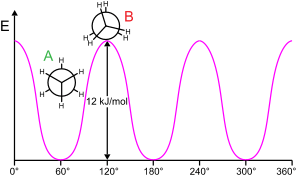
Rotating a molecular substructure about a twistable bond usually requires energy. The minimum energy to produce a 360° bond rotation is called the rotational barrier.
Ethane gives a classic, simple example of such a rotational barrier, sometimes called the "ethane barrier". Among the earliest experimental evidence of this barrier (see diagram at left) was obtained by modelling the entropy of ethane.[15] The three hydrogens at each end are free to pinwheel about the central carbon-carbon bond when provided with sufficient energy to overcome the barrier. The physical origin of the barrier is still not completely settled,[16] although the overlap (exchange) repulsion[17] between the hydrogen atoms on opposing ends of the molecule is perhaps the strongest candidate, with the stabilizing effect of hyperconjugation on the staggered conformation contributing to the phenomenon.[18] However, theoretical methods that use an appropriate starting point (orthogonal orbitals) find that hyperconjugation is the most important factor in the origin of the ethane rotation barrier.[19][20]
As far back as 1890–1891, chemists suggested that ethane molecules preferred the staggered conformation with the two ends of the molecule askew from each other.[21][22][23][24]
Production
After methane, ethane is the second-largest component of natural gas. Natural gas from different gas fields varies in ethane content from less than 1% to more than 6% by volume. Prior to the 1960s, ethane and larger molecules were typically not separated from the methane component of natural gas, but simply burnt along with the methane as a fuel. Today, ethane is an important petrochemical feedstock and is separated from the other components of natural gas in most well-developed gas fields. Ethane can also be separated from petroleum gas, a mixture of gaseous hydrocarbons produced as a byproduct of petroleum refining. Economics of building and running processing plants can change, however. If the relative value of sending the unprocessed natural gas to a consumer exceeds the value of extracting ethane, ethane extraction might not be run, which could cause operational issues managing the changing quality of the gas in downstream systems.
Ethane is most efficiently separated from methane by liquefying it at cryogenic temperatures. Various refrigeration strategies exist: the most economical process presently in wide use employs a turboexpander, and can recover more than 90% of the ethane in natural gas. In this process, chilled gas is expanded through a turbine, reducing the temperature to about −100 °C (−148 °F). At this low temperature, gaseous methane can be separated from the liquefied ethane and heavier hydrocarbons by distillation. Further distillation then separates ethane from the propane and heavier hydrocarbons.
Ethane can be formed from the electrolysis of acetate salts:
2 CH3COONa + 2 H2O → C2H6 + 2 CO2 + H2 + 2 NaOH
Uses
The chief use of ethane is the production of ethene (ethylene) by steam cracking. When diluted with steam and briefly heated to very high temperatures (900 °C or more), heavy hydrocarbons break down into lighter hydrocarbons, and saturated hydrocarbons become unsaturated. Ethane is favored for ethene production because the steam cracking of ethane is fairly selective for ethene, while the steam cracking of heavier hydrocarbons yields a product mixture poorer in ethene and richer in heavier alkenes (olefins), such as propene (propylene) and butadiene, and in aromatic hydrocarbons.
Experimentally, ethane is under investigation as a feedstock for other commodity chemicals. Oxidative chlorination of ethane has long appeared to be a potentially more economical route to vinyl chloride than ethene chlorination. Many processes for producing this reaction have been patented, but poor selectivity for vinyl chloride and corrosive reaction conditions (specifically, a reaction mixture containing hydrochloric acid at temperatures greater than 500 °C) have discouraged the commercialization of most of them. Presently, INEOS operates a 1000 t/a (tonnes per annum) ethane-to-vinyl chloride pilot plant at Wilhelmshaven in Germany.
Similarly, the Saudi Arabian firm SABIC has announced construction of a 30,000 tonnes per annum plant to produce acetic acid by ethane oxidation at Yanbu. The economic viability of this process may rely on the low cost of ethane near Saudi oil fields, and it may not be competitive with methanol carbonylation elsewhere in the world.
Ethane can be used as a refrigerant in cryogenic refrigeration systems. On a much smaller scale, in scientific research, liquid ethane is used to vitrify water-rich samples for electron microscopy (cryo-electron microscopy). A thin film of water, quickly immersed in liquid ethane at −150 °C or colder, freezes too quickly for water to crystallize. Slower freezing methods can generate cubic ice crystals that can disrupt soft structures by damaging the samples and reduce image quality by scattering the electron beam before it can reach the detector.
Health and safety
At room temperature, ethane is an extremely flammable gas. When mixed with air at 3.0%–12.5% by volume, it forms an explosive mixture.
Some additional precautions are necessary where ethane is stored as a cryogenic liquid. Direct contact with liquid ethane can result in severe frostbite. Until they warm to room temperature, the vapors from liquid ethane are heavier than air and can flow along the floor or ground, gathering in low places; if the vapors encounter an ignition source, the chemical reaction can flash back to the source of ethane from which they evaporated.
Ethane can displace oxygen and become an asphyxiation hazard. Ethane poses no known acute or chronic toxicological risk. It is not a carcinogen.[25]
Atmospheric and extraterrestrial ethane
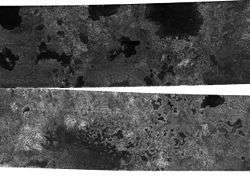
Ethane occurs as a trace gas in the Earth's atmosphere, currently having a concentration at sea level of 0.5 ppb,[26] though its preindustrial concentration is likely to have been only around 0.25 part per billion since a significant proportion of the ethane in today’s atmosphere may have originated as fossil fuels. Global ethane quantities have varied over time, likely due to flaring at natural gas fields.[27] Global ethane emission rates declined from 1984 to 2010,[27] though increased shale gas production at the Bakken Formation in the U.S. has arrested the decline by half.[28] [29]
Although ethane is a greenhouse gas, it is much less abundant than methane, has a lifetime of only a few months compared to over a decade,[30] and is also less efficient at absorbing radiation relative to mass. In fact, ethane’s global warming potential largely results from its conversion in the atmosphere to methane.[31] It has been detected as a trace component in the atmospheres of all four giant planets, and in the atmosphere of Saturn's moon Titan.[32]
Atmospheric ethane results from the Sun’s photochemical action on methane gas, also present in these atmospheres: ultraviolet photons of shorter wavelengths than 160 nm can photo-dissociate the methane molecule into a methyl radical and a hydrogen atom. When two methyl radicals recombine, the result is ethane:
- CH4 → CH3• + •H
- CH3• + •CH3 → C2H6
On Earth’s atmosphere, hydroxyl radicals convert ethane to methanol vapor with a half-life of around three months.[30]
It was once widely hypothesized that ethane produced in this fashion on Titan rained back onto the moon's surface, and over time had accumulated into hydrocarbon seas or oceans covering much of the moon's surface. Infrared telescopic observations cast significant doubt on this hypothesis, and the Huygens probe, which landed on Titan in 2005, failed to observe any surface liquids, although it did photograph features that could be presently dry drainage channels. In December 2007 the Cassini probe found at least one lake at Titan’s south pole, now called Ontario Lacus because of the lake's similar area to Lake Ontario on Earth (approximately 20,000 km2). Further analysis of infrared spectroscopic data presented in July 2008[33] provided stronger evidence for the presence of liquid ethane in Ontario Lacus.
In 1996, ethane was detected in Comet Hyakutake,[34] and it has since been detected in some other comets. The existence of ethane in these distant solar system bodies may implicate ethane as a primordial component of the solar nebula from which the sun and planets are believed to have formed.
In 2006, Dale Cruikshank of NASA/Ames Research Center (a New Horizons co-investigator) and his colleagues announced the spectroscopic discovery of ethane on Pluto's surface.[35]
References
- Nomenclature of Organic Chemistry : IUPAC Recommendations and Preferred Names 2013 (Blue Book). Cambridge: The Royal Society of Chemistry. 2014. p. 4. doi:10.1039/9781849733069-FP001. ISBN 978-0-85404-182-4.
Similarly, the retained names ‘ethane’, ‘propane’, and ‘butane’ were never replaced by systematic names ‘dicarbane’, ‘tricarbane’, and ‘tetracarbane’ as recommended for analogues of silane, ‘disilane’; phosphane, ‘triphosphane’; and sulfane, ‘tetrasulfane’.
- "Ethane – Compound Summary". PubChem Compound. USA: National Center for Biotechnology Information. 16 September 2004. Retrieved 7 December 2011.
- Lide, D. R., ed. (2005). CRC Handbook of Chemistry and Physics (86th ed.). Boca Raton (FL): CRC Press. p. 8.88. ISBN 0-8493-0486-5.
- Faraday, Michael (1834). "Experimental researches in electricity: Seventh series". Philosophical Transactions. 124: 77–122. doi:10.1098/rstl.1834.0008.
- Kolbe, Hermann; Frankland, Edward (1849). "On the products of the action of potassium on cyanide of ethyl". Journal of the Chemical Society. 1: 60–74. doi:10.1039/QJ8490100060.
- Frankland, Edward (1850). "On the isolation of the organic radicals". Journal of the Chemical Society. 2 (3): 263–296. doi:10.1039/QJ8500200263.
- Schorlemmer, Carl (1864). "Ueber die Identität des Aethylwasserstoffs und des Methyls" (PDF). Annalen der Chemie und Pharmacie. 132 (2): 234–238. doi:10.1002/jlac.18641320217.
- Roscoe, H.E.; Schorlemmer, C. (1881). Treatise on Chemistry. 3. Macmillan. pp. 144–145.
- Watts, H. (1868). Dictionary of Chemistry. 4. p. 385.
- "the definition of ethyl". Dictionary.com. Retrieved 2016-03-12.
- Van Nes, G.J.H.; Vos, A. (1978). "Single-crystal structures and electron density distributions of ethane, ethylene and acetylene. I. Single-crystal X-ray structure determinations of two modifications of ethane" (PDF). Acta Crystallographica Section B. 34 (6): 1947. doi:10.1107/S0567740878007037.
- "Ethane as a solid". Retrieved 2019-12-10.
- Harmony, Marlin D. (1990-11-15). "The equilibrium carbon–carbon single‐bond length in ethane". The Journal of Chemical Physics. 93 (10): 7522–7523. Bibcode:1990JChPh..93.7522H. doi:10.1063/1.459380. ISSN 0021-9606.
- J, McMurry (2012). Organic chemistry (8 ed.). Belmont, CA: Brooks. p. 95. ISBN 9780840054449.
- Kemp, J. D.; Pitzer, Kenneth S. (1937). "The Entropy of Ethane and the Third Law of Thermodynamics. Hindered Rotation of Methyl Groups". Journal of the American Chemical Society. 59 (2): 276. doi:10.1021/ja01281a014.
- Ercolani, G. (2005). "Determination of the Rotational Barrier in Ethane by Vibrational Spectroscopy and Statistical Thermodynamics". J. Chem. Educ. 82 (11): 1703–1708. Bibcode:2005JChEd..82.1703E. doi:10.1021/ed082p1703.
- Pitzer, R.M. (1983). "The Barrier to Internal Rotation in Ethane". Acc. Chem. Res. 16 (6): 207–210. doi:10.1021/ar00090a004.
- Mo, Y.; Wu, W.; Song, L.; Lin, M.; Zhang, Q.; Gao, J. (2004). "The Magnitude of Hyperconjugation in Ethane: A Perspective from Ab Initio Valence Bond Theory". Angew. Chem. Int. Ed. 43 (15): 1986–1990. doi:10.1002/anie.200352931. PMID 15065281.
- Pophristic, V.; Goodman, L. (2001). "Hyperconjugation not steric repulsion leads to the staggered structure of ethane". Nature. 411 (6837): 565–8. doi:10.1038/35079036. PMID 11385566.
- Schreiner, P. R. (2002). "Teaching the right reasons: Lessons from the mistaken origin of the rotational barrier in ethane". Angewandte Chemie International Edition. 41 (19): 3579–81, 3513. doi:10.1002/1521-3773(20021004)41:19<3579::AID-ANIE3579>3.0.CO;2-S. PMID 12370897.
- Bischoff, CA (1890). "Ueber die Aufhebung der freien Drehbarkeit von einfach verbundenen Kohlenstoffatomen". Chem. Ber. 23: 623. doi:10.1002/cber.18900230197.
- Bischoff, CA (1891). "Theoretische Ergebnisse der Studien in der Bernsteinsäuregruppe". Chem. Ber. 24: 1074–1085. doi:10.1002/cber.189102401195.
- Bischoff, CA (1891). "Die dynamische Hypothese in ihrer Anwendung auf die Bernsteinsäuregruppe". Chem. Ber. 24: 1085–1095. doi:10.1002/cber.189102401196.
- Bischoff, C.A.; Walden, P. (1893). "Die Anwendung der dynamischen Hypothese auf Ketonsäurederivate". Berichte der Deutschen Chemischen Gesellschaft. 26 (2): 1452. doi:10.1002/cber.18930260254.
- Vallero, Daniel (June 7, 2010). "Cancer Slope Factors". Environmental Biotechnology: A Biosystems Approach. Academic Press. p. 641. doi:10.1016/B978-0-12-375089-1.10014-5. ISBN 9780123750891.
- Trace gases (archived). Atmosphere.mpg.de. Retrieved on 2011-12-08.
- Simpson, Isobel J.; Sulbaek Andersen, Mads P.; Meinardi, Simone; Bruhwiler, Lori; Blake, Nicola J.; Helmig, Detlev; Rowland, F. Sherwood; Blake, Donald R. (2012). "Long-term decline of global atmospheric ethane concentrations and implications for methane". Nature. 488 (7412): 490–494. Bibcode:2012Natur.488..490S. doi:10.1038/nature11342. PMID 22914166.
- Kort, E. A.; Smith, M. L.; Murray, L. T.; Gvakharia, A.; Brandt, A. R.; Peischl, J.; Ryerson, T. B.; Sweeney, C.; Travis, K. (2016). "Fugitive emissions from the Bakken shale illustrate role of shale production in global ethane shift". Geophysical Research Letters. 43 (9): 4617–4623. Bibcode:2016GeoRL..43.4617K. doi:10.1002/2016GL068703.
- "One oil field a key culprit in global ethane gas increase". University of Michigan. April 26, 2016.
- Aydin, Kamil Murat; Williams, M.B. and Saltzman, E.S.; ‘Feasibility of reconstructing paleoatmospheric records of selected alkanes, methyl halides, and sulfur gases from Greenland ice cores’; Journal of Geophysical Research; volume 112, D07312
- Hodnebrog, Øivind; Dalsøren, Stig B. and Myrhe, Gunnar; ‘Lifetimes, direct and indirect radiative forcing, and globalwarming potentials of ethane (C2H6), propane (C3H8),and butane (C4H10)’; Atmospheric Science Letters; 2018;19:e804
- Brown, Bob; et al. (2008). "NASA Confirms Liquid Lake on Saturn Moon". NASA Jet Propulsion Laboratory.
- Brown, R. H.; Soderblom, L. A.; Soderblom, J. M.; Clark, R. N.; Jaumann, R.; Barnes, J. W.; Sotin, C.; Buratti, B.; et al. (2008). "The identification of liquid ethane in Titan's Ontario Lacus". Nature. 454 (7204): 607–10. Bibcode:2008Natur.454..607B. doi:10.1038/nature07100. PMID 18668101.
- Mumma, Michael J.; et al. (1996). "Detection of Abundant Ethane and Methane, Along with Carbon Monoxide and Water, in Comet C/1996 B2 Hyakutake: Evidence for Interstellar Origin". Science. 272 (5266): 1310–1314. Bibcode:1996Sci...272.1310M. doi:10.1126/science.272.5266.1310. PMID 8650540.
- Stern, A. (November 1, 2006). "Making Old Horizons New". The PI's Perspective. Johns Hopkins University Applied Physics Laboratory. Archived from the original on August 28, 2008. Retrieved 2007-02-12.
External links
| Wikimedia Commons has media related to Ethane. |


